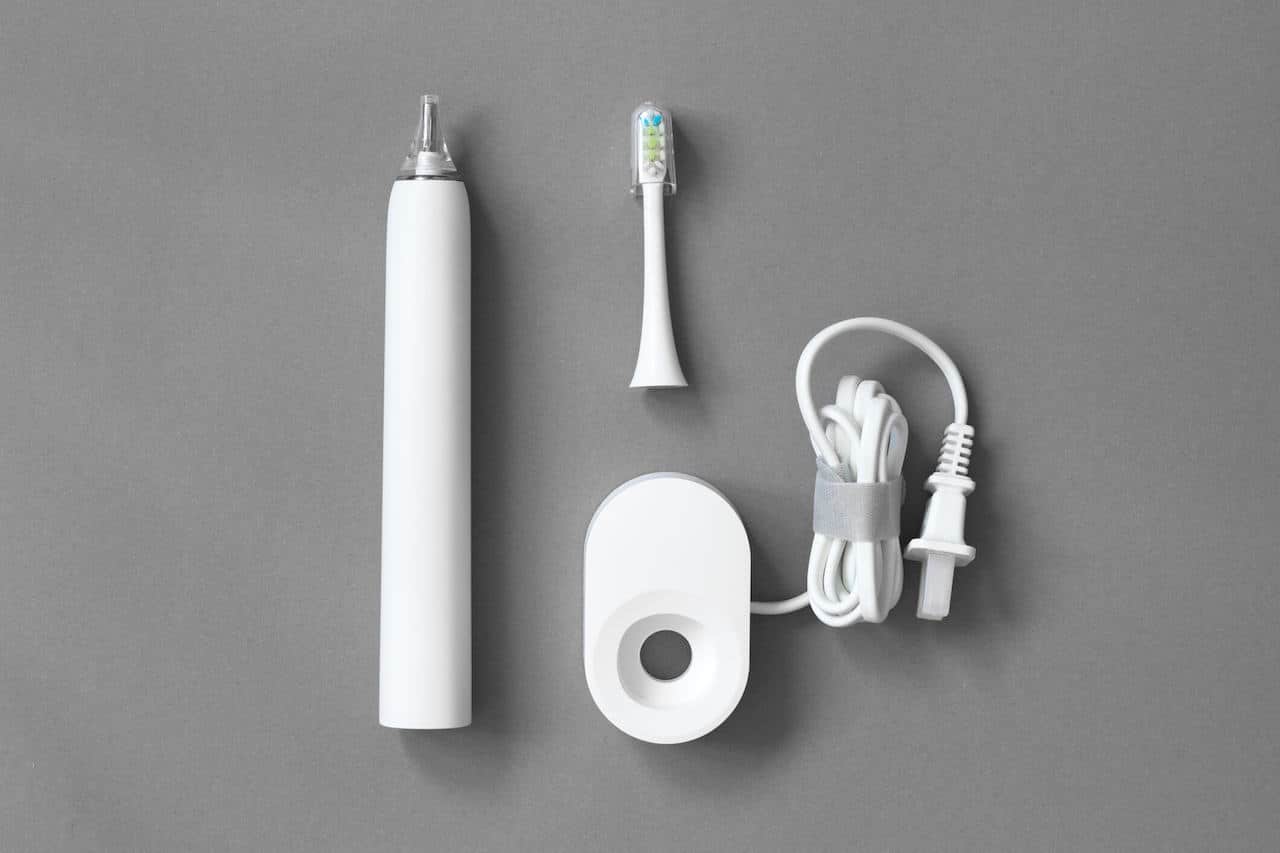No products in the cart.
Do you ever sit and think about the state of your toothbrush? Is it a recommended brand? Are the bristles the right level of softness? Do you have a moldy toothbrush?
Wait, mold? On a toothbrush?
A moldy toothbrush might not have crossed your mind, but it’s fairly simple to achieve. And might be happening right now… To the toothbrush sitting in your bathroom. That you may or may not have just brushed your teeth with.
I’m going to go ahead and say what we’re all thinking.
Yuck!
Unfortunately, those clean teeth helpers are tremendously prone to bacterial growth and mold. And let’s be honest, no one wants to brush with a moldy toothbrush.
MOLD AND YOUR HEALTH
Let’s start with mold growth so you can get a better picture of how your poor toothbrush can become a victim.
Researchers have identified tens of thousands of mold species identified thus far.¹ They reproduce asexually by creating tiny microscopic spores that mosey along with the air current. So, this fungus exists pretty much everywhere.² Outside, inside, your car, and even your bathroom. Normally, these spores aren’t a problem. Low in volume in the air they’re floating in, they kind of exist in the environment and cause no problem.

Or at least, they don’t cause an issue until they find a nice little place to call home. What makes a great home for mold? These hardy little spores only have four requirements: oxygen (easy), food (they eat almost everything), temperature (40-90 degrees Fahrenheit), and moisture.³ The last one is the key ingredient these spores look for when deciding to make themselves a little home. The other three are fairly easy to come by.
Once they find a wet little environment, they’ll settle in and begin to colonize. That single spore creates more colonized mold and even more spores that it pumps into the air. With the ability to grow in as little as 24 hours, a small mold problem can easily turn into a large issue. Not to mention some mold species’ ability to create microscopic toxins, called mycotoxins.⁴ The issue is that exposure to mold and these invisible toxins can trigger a laundry list of adverse health reactions.⁵
Now imagine that you’re putting that situation in your mouth… With a moldy toothbrush.
MOLDY TOOTHBRUSH ENVIRONMENTS
Like choosing a home in those HGTV shows, your dedicated mouth scrubber is the top contender for a place to habitat. It ticks every single box for a moldy home sweet home. Mold spores also aren’t joining the debate over whether an electric or manual brush is better. They’re equal opportunity and lovers of all things wet. When it comes to a toothbrush, that’s pretty much how they spend their entire existence.
Dentists recommend that we all brush our teeth twice a day for two minutes.⁶ That means for four minutes a day, these little scrubby brushes are wet and inside of our mouths. Now picture this- when we’re finished, where do these brushes go? In a cup, a cabinet, the counter, or maybe even a drawer? It’s usually the dealer’s choice. When we put them down though, do these little rockstars of health actually get the chance to dry? Or are we enabling them to stay perpetually wet?

With how quickly mold spores can grow (and their uncanny ability to end up anywhere and everywhere) a persistently wet toothbrush pretty much leaves the door open with a welcome sign out front for mold.⁷
The wet toothbrush isn’t the only problem, though. We keep our bathrooms in a constant state of moist air saturation. Between the steamy showers, soaks in the tub, wet towels, and running faucet, we blast it with moisture. Without taking the proper steps to keep that area dry, the entire bathroom (plus your toothbrush) can easily become a moldy safe haven.
Between a moldy bathroom and a moldy toothbrush, that level of exposure can quickly begin affecting your health.
Plus, it’s gross to think about brushing mold and bacteria into your teeth.
SAYING NO TO THE MOLDY TOOTHBRUSH
Luckily, there are a few easy steps to take to avoid a moldy toothbrush. All it takes is a slight adjustment to our routines.
STORAGE
The best thing to start with is putting your toothbrush in the right place. That means bye, bye countertops and tight toothbrush containers. The American Dental Association says these little scrubbers (manual or electric) need to breathe! Airflow helps dry out the toothbrush so that it stays wet for as short amount of time as possible. Less wetness means fewer opportunities for mold spores to start growing.
Storing manual toothbrushes in a bottomless holder will also help to stop mold. When we place toothbrushes into a cup with a solid bottom, water drips down the brush and pools. That creates a wet environment for mold to find its way into. If you have a cup right now, it might be a good idea to take a little peek to see what’s inside. It may or may not traumatize you so make sure to approach said cup with caution! Laying a toothbrush on the counter is a no-no too. It allows water to pool around the bristles and creates more moldy opportunities.
Also, keep it away from the toilet! No one, I repeat, no one wants toilet particles all over something they put in their mouth. Slightly gagging just thinking about it.
CLEANING
These little brushes are hard at work every day keeping those pearly whites clean. They need cleaning too though! Eventually, bacteria and random mold particles can build up with continued use. It’s a great idea to disinfect them with a good soak in anti-bacterial mouthwash about once a week to get rid of that gunk.⁸ So throw that toothbrush or toothbrush head a nice little spa day asap.

For electric toothbrushes, cleaning is even more important. That base doesn’t get replaced, but it collects any dripping water from the top every single day. While you’re soaking the head of the brush, go ahead and deep clean the rest of that trusty little tool as well. Forewarning though! If you haven’t cleaned it in a while, you might want to prepare yourself for a potential mold-filled and icky situation.
You can also help keep your toothbrush clean by adding a few daily steps. Run the brush under warm water after every use to get rid of any excess toothpaste, saliva, and whatnot off of the bristles and the brush. Then give it a little tap tap on the edge of the sink or gently shake it to get as much water as possible off of the brush. Again (I’ll keep saying it like a mantra), less wet opportunities for mold.
REPLACE
Most of us are probably guilty of not replacing toothbrushes when we’re supposed to… Between running late in the mornings or staring at yourself bleary-eyed in the mirror before bed, toothbrush replacement is most likely not at the forefront of our brains. Not replacing them could lead to brushing with a moldy toothbrush, though. As the brush ages, it becomes more porous, which means it retains moisture even if you dry it properly.
The American Dental Association recommends the same replacement routine for manual toothbrushes and electric heads: 3 months. Four months is okay, but honestly, sooner is better in this case. No more waiting until the bristles fall off or look like some kind of weird abstract art piece.
Set a reminder on your phone if you’re not great at remembering or (like me) your concept of time always seems skewed and months feel like weeks. Technology for the win, right?
BATHROOM UPKEEP
It doesn’t matter how dry and clean you keep your toothbrush. If your bathroom is a wet zone, mold will take that as an invitation to start growing. More mold means more spores in the air. Inevitably, some of those spores will come into contact with your drying but still wet brush.
The great news is that there are quite a few steps you can take to decrease the moisture level in your bathroom. Creating better airflow by turning on the exhaust fan and cracking a door will help keep the air in the bathroom dry. Wiping up any wet spots on the floor or countertop help remove wet havens for mold spores. Drying items like towels, shower curtains, and bathmats reduce damp bathroom contents.
A clean and healthy bathroom means no moldy toothbrush for you!
SMALL STEPS NOW EQUALS CLEANER TOOTHBRUSHES FOR ALL
By this point, you might be thoroughly freaked out by the state of your poor toothbrush. The scandal, am I right? Brushing with a moldy toothbrush is not exactly what dentists had in mind while asking us to practice dental hygiene. That’s why toothbrush maintenance is so important!
Clean teeth won’t do you much good if mold exposure is affecting your health and causing symptoms like brain fog, chronic fatigue, or joint pain. The good news is that with a little more awareness, an extra bit of effort, and a repeat phone reminder, we can keep those awesome tools clean and mold-free.
Goodbye moldy toothbrushes and hello healt
- Centers for Disease Control and Prevention. (2020, August 11). Basic facts about mold and dampness. Centers for Disease Control and Prevention. Retrieved August 17, 2021, from https://www.cdc.gov/mold/faqs.htm.
- Environmental Protection Agency. (n.d.). Mold. EPA. Retrieved August 17, 2021, from https://www.epa.gov/mold.
- Lstiburek, J., Brennan, T., & Yost, N. (2002, January 15). Rr-0208: What you need to know about mold. Building Science Corporation. Retrieved August 18, 2021, from https://www.buildingscience.com/documents/reports/rr-0208-what-you-need-to-know-about-mold/view.
- World Health Organization. (n.d.). Mycotoxins. World Health Organization. Retrieved August 26, 2021, from https://www.who.int/news-room/fact-sheets/detail/mycotoxins.
- Environmental and Occupational Health Assessment Program, & Environmental and Occupational Health Assessment Program, & Health Science Section, Mold Basics for Primary Care Clinicians (2009). Hartford, CT; Connecticut Department of Public Health. , H. S. S., Mold Basics for Primary Care Clinicians 1–10 (2009). Hartford, CT; Connecticut Department of Public Health.
- Department of Scientific Information, Evidence Synthesis & Translation Research, ADA Science & Research Institute, LLC. (2019, February 26). Oral Health Topics: Toothbrushes. American Dental Association. Retrieved September 16, 2021, from https://www.ada.org/en/member-center/oral-health-topics/toothbrushes.
- Yadav, S. (2015). Toothbrushes In Bathroom-Clean Before You Clean. Journal of Advanced Medical and Dental Sciences Research, 3(5), S57.
- Sato, S., Ito, I. Y., Lara, E. H. G., Panzeri, H., Albuquerque Junior, R. F. D., & Pedrazzi, V. (2004). Bacterial survival rate on toothbrushes and their decontamination with antimicrobial solutions. Journal of Applied Oral Science, 12, 99-103.
Still Have Questions?
A member of our team is here to help! Click on “Get Started ➤” below to book a consultation with a member of the HOMECLEANSE team. We have a few quick questions that will help us put together a roadmap to solve or prevent all of your mold problems.
Two minutes of your time could lead to better health for you and your family.
